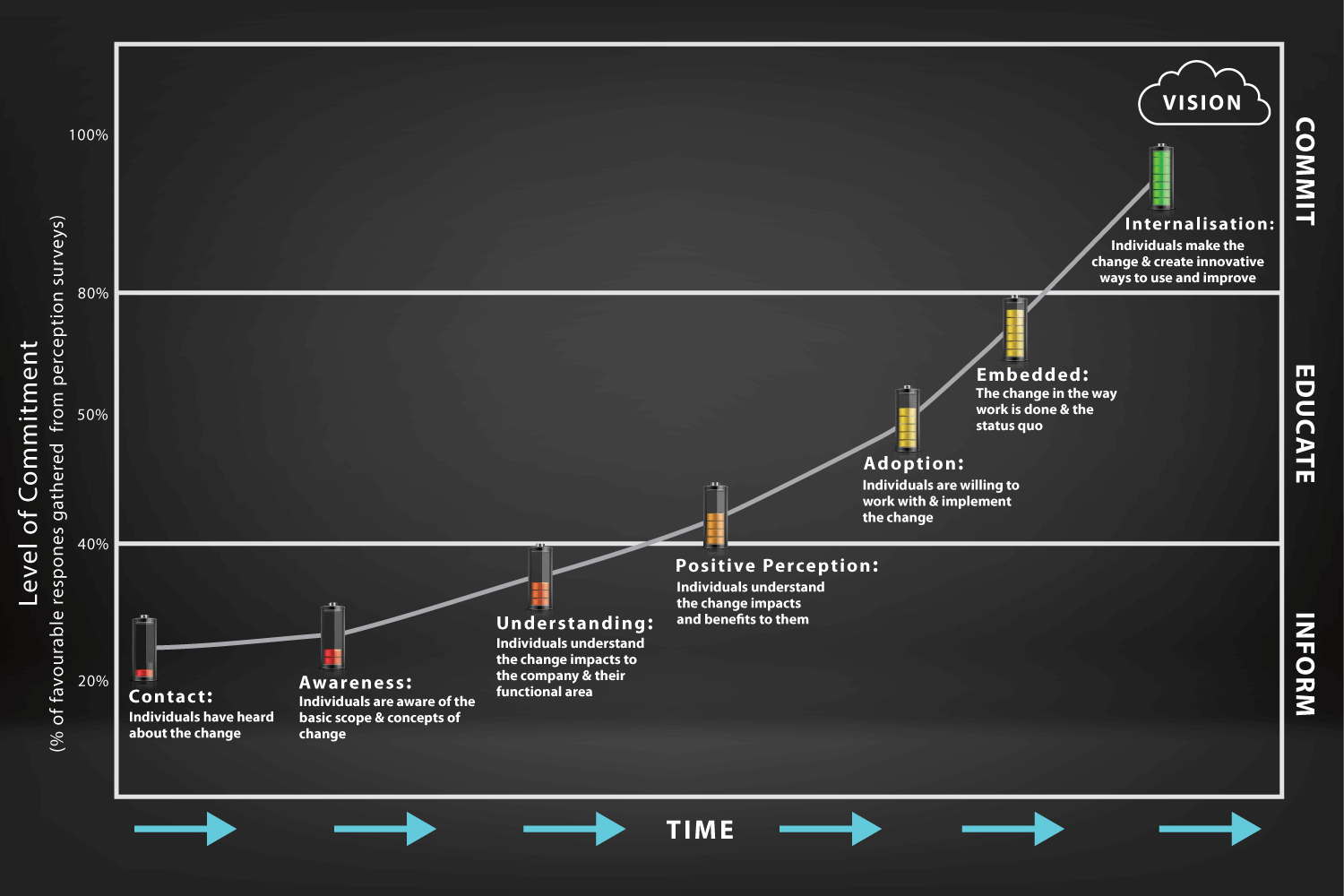“Data is the new oil” has become an industry adage of our generation.
It is because data-driven insights can not only transform how enterprises operate, but it also empowers workers at every level of hierarchy to become truly a ‘knowledge worker’.
But, despite promises, so many companies are still struggling to derive value from their data investments.
Gartner says that 70-80% of enterprise investments in data fail to deliver on their expected ROI.
So, how are successful enterprises differentiating and making significant headways with data?
It turns out that investments into technology and making hirings to fill the gap are not going to be enough. The essential component of any successful analytics program is the ability to manage the change well and to make the culture more receptive to and driven by analytics.
Quite often, enterprises make significant investments into the program, only to find that the whole program has been received with low user adoption.
When this happens, it can threaten & place your entire initiative in jeopardy, putting you at a severe competitive disadvantage.
To ensure that your program does not fall into this, you will need to execute a detailed and intricate data driven change management program.
Why Is Change Management Needed For Analytics Projects?
The success/failure of your enterprise analytics project will be driven by the success of your change management program.
Analytics is not only going to be an investment into technologies, but it will also require a mindset shift that needs to be inculcated, and people need to be encouraged to adapt to this new paradigm.
To manage this effectively, without facing significant resistance or set-back that can derail the whole process, you need to have a focused and collaborative approach towards managing the entire change process.
A successful change management program will result in an increased sense of ownership among the analytics users that empowers them with “actionable insights” – feeding a virtuous loop of analytics consumption to inform actions and vice versa feeding the data from outcomes to the analytics engine.
4 Pillars Of Successful Analytics Implementation
For your analytics investments to be successful, you will first need to transform your organization along these crucial pillars:-
1. Shattered Data Silos
Data silos, which may exist for technical, cultural, or structural reasons, can threaten the effectiveness of the whole analytics set-up. Hence, they need to be effectively done away with. It will bring about uniformity/standardization in how data is prepared, used and consumed within the enterprise as well as ensure that everyone within the organization has access to critical data points that will provide insights to help them make better decisions.
2. Enabled Analytics Leaders And Users
Analytics users will be the knowledge workers of the 21st century and will be actively using and consuming data for cleaning, wrangling and analysis needs. For these purposes, sufficient training needs to be provided to them so that they can perform data analysis for themselves and create customized charts & visualizations for top-notch visualization. For up-skilling the users, there needs to be created training road-map and analytics workshops can be conducted by taking into account the user’s current skill level. Without this, they might be unable to use the tool effectively, leading to sub-optimal adoption.
3. Analytics Program Governance
Effective project governance will require a team that will lay down the rules for data sharing & access, roles and responsibilities and crisis management. Effective governance will ensure that the program outcomes are aligned with the business objectives.
4. Analytics Embedded Into Day-To-Day Decision Making
Adoption can be accelerated by making the analytics solution seamless and easy to consume. This can be done by bringing it as close to the user as possible, possibly by embedding it into the applications that are already a part of the end-user workflow. By removing the need for a separate log-in, the user will be encouraged to access the analytics solution more frequently, encouraging faster adoption.
By solidifying these pillars of change, you will be well on your way to fostering strategic insights from your analytics that will translate to direct business growth.
With all the changes a business intelligence or data analytics platform needs to find the right implementation partner in us for your needs
4 Steps To Create Data-Driven Change Management Program
1. Create Training Programs
Users need to be on board with analytics tools and technologies so that they can utilize them to their advantage. For this, a dedicated training program that is either done in-house or entirely outsourced to vendors will be needed. The program can focus on a comprehensive set of users or be focused on enabling champion trainers – key leaders in crucial functions who will then take up the responsibility of encouraging it and imparting training wherever necessary throughout the organization.
2. Get Leadership Sponsors
Strong leadership buy-in is going to be very crucial. According to TDWI, for 41% of successful analytics projects surveyed, sponsorship from the senior executive was critical to the project’s success. The change process is likely to encounter sceptics and detractors along the way who would resist forsaking the existing culture of reporting in the place of a new one & if a senior executive is backing the whole process. It makes it easy to get over these hurdles and generate consensus for the change. End-of-life strategy for existing data analytics tools such as MS Excel will require leaders to sponsor the change.
3. Make Analytics A Part Of Culture
Analytics cannot be executed as if it is a one-time program. Analytics needs to be treated as a mindset that should be ingrained into user habits so that they are using the technologies and tools for making informed and effective decisions. It can be achieved by embedding the analytics reports into existing user workflow applications. By bringing analytics closer to the user, you will encourage its adoption and use.
4. Create Rewards & Recognition Linked To Analytics Adoption
Reward programs to identify top adopters who have taken active initiatives. This will encourage more people to buy in into the program and reinforce the idea that the effort has the backing of the company’s management. It will help to bring about change in a positive direction. When wins from the change program are highlighted, more people will be converted from being program skeptics to program advocates.
The objective will be better served if there is a dedicated change management team that is responsible for fostering and facilitating active stakeholder & cross-functional communication and collaboration.
By making concerted steps in the right direction and by creating a phased-approach timeline by utilizing the commitment curve, it will encourage and drive end-user adoption and create a successful change management outcome.
The change management team will need to work closely with company executives to draft a vision with the change management plan, after a strategy has been laid out, this team will be responsible for leading and executing the program with the right mandate, direction, and transparency.
By leveraging Kotter’s principles, listening to the feedback from the users, and leveraging the right collaboration tools to engage internal and external teams, you will be on your way to success.
Wrapping Up

The Commitment curve shows the journey that organizations need to take to make the transition to a level where analytics is internalized and consumed actively as a day-to-day operation within the organization for creating effective and informed decisions. The change management team, by working closely with and taking constant feedback from executive sponsors, functional heads, on-the-floor managers, and the analytics users must identify bottlenecks (if any) that are preventing the organization from moving across this line concerning the desired change. By proactively identifying and removing obstacles, the change management team will set your organization on the road to success and the desired ROI on your analytics initiatives.
Explore our wide range of services and solutions offered and we can provide tailored solutions as per your requirements



